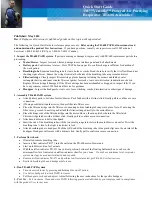
Page 27
Installer’s Guide
Service Maintenance
Service maintenance should be performed by qualified service
personnel.
Cooling Season
To keep the unit operating safely and efficiently, the manufacturer
recommends that a qualified service technician check the entire
system at least once each season or more often if needed. The
service technician should examine these areas of the unit:
filters (for cleaning or replacement)
motors and drive system components
economizer gaskets (for possible replacement)
safety controls (for mechanical cleaning)
electrical components and wiring (for possible replacement
and connection tightness)
condensate drain (for proper sealing and cleaning)
unit duct connections (to see that they are physically sound
and sealed to the unit casing)
unit mounting support (for structural integrity)
the unit (for obvious unit deterioration)
Owner Maintenance
Some of the periodic maintenance functions of the unit can be
performed by the owner; this includes replacing the disposable
or cleaning the permanent air filters, cleaning the unit cabinet,
and conducting a general unit inspection on a regular basis.
Filters
When
the system is in constant operation,
inspect the filters
at least once each month.
If you have disposable-type filters, replace them with new filters
of the same type and size.
Do not attempt to clean dispos-
able filters.
Permanent-type filters can be cleaned by washing them with a
mild detergent and water. Make sure that the filters are thoroughly
dry before reinstalling them.
NOTE:
It may be necessary to replace permanent filters
annually if washing fails to clean the filter or if the filter shows
signs of deterioration. Be sure to use the same type and
size as was originally installed.
Condenser Coil
Be sure to keep all vegetation and debris away from the condenser
coil area.
Maintenance
Heating Season
Complete the following unit inspections and service routines
described at the beginning of each heating season.
Visually inspect the unit to ensure that the airflow required
for combustion and condenser coil is not obstructed from the
unit.
Inspect the control panel wiring to verify that all electrical
connections are tight and that the wire insulation is intact.
Check the operation of the gas ignition system as follows:
Turn off the gas supply with the unit operating to verify that
the gas valve closes and that a re-ignition cycle is initiated
by the unit.
Visually inspect the inside of the burners and the burner ports
for deposit buildup and corrosion. Wipe and brush the inside
of the burner and the burner ports and then clean with a dry
cloth. If the deposit buildup or corrosion is excessive, replace
the burners.
FLUE CLEANING
Cooling Cycle:
Thermostate call for cooling (2-stage thermostat)
Call for 1st stage cooling only:
With the room thermostat set to
COOL
and the fan set to
AUTO
,
power is supplied from the room thermostat "O" terminal to the
unit switchover valve coil (SOV) and the "O" terminal on the
ECMC board. This energizes the switchover valve (SOV) placing
it in the position for cooling (it is in the position for heating when
de-energized). On a call for cooling, power is supplied to the unit
from the room thermostat (Y1) and (G) terminal. (Y1) provides
power to the compressor contactor (CC), the defrost control
(DFC) and the electronically commutated motor control (ECMC).
(G) provides power to the (ECMC) for low speed (ECM) indoor
fan motor operation.
The energized compressor contactor (CC) completes the circuit
to the compressor for 1st stage (Low) operation and the outdoor
single speed fan motor (ODM). The (G) signal energizes the
(ECMC) for the indoor fan motor (ECM) to operate at constant
circulation. The thermostat will continue to cycle the compressor
and fans to maintain the desired temperature.
Call for 2nd stage after 1st stage
On a call for 2nd stage cooling, power is supplied from the room
thermostat (Y2) terminal to the compressor rectifier (ACR) and
the (ECMC). This energizes the (ACR) switching the compressor
to 2nd stage (High) operation. The (ECMC) is energized for indoor
fan motor (ECM) high speed fan operation. The room thermostat
will continue to cycle the system between 1st and 2nd stage to
maintain the desired temperature.
EXPLOSION HAZARD!
To prevent an explosion or possible injury, death, and equip-
ment damage. Do not store combustible materials, gasoline,
or other flammable vapors or liquids near the unit.
WARNING
!
Before each heating season, the flue should be inspected for signs
of flaking rust and soot deposits.
Dirty flues should be cleaned by
qualified service personnel ONLY
using the following procedure:
1. Turn the room thermostat to the OFF position. Turn the main
power disconnect OFF. Turn the manual gas valve OFF.
2. Remove the flue hood and the CONTROL/HEAT access panel.
3. Remove the combustion blower assembly from the flue box.
Remove the flue box and the flue restrictors.
4. Remove all wires from the gas valve while carefully noting their
locations.
5. Disconnect the gas supply line from the valve.
CAUTION
Never use combustible cleaning fluids on any part of the
furnace.
Содержание 4DCZ6036
Страница 5: ...Page 5 Installer s Guide Figure 2 4DCZ6036 2 of 3...
Страница 6: ...Page 6 Installer s Guide Figure 3 4DCZ6036 3 of 3...
Страница 7: ...Page 7 Installer s Guide Figure 4 4DCZ6048 through 4DCZ6060 1 of 3...
Страница 8: ...Page 8 Installer s Guide Figure 5 4DCZ6048 through 4DCZ6060 2 of 3...
Страница 9: ...Page 9 Installer s Guide Figure 6 4DCZ6048 through 4DCZ6060 3 of 3...


































